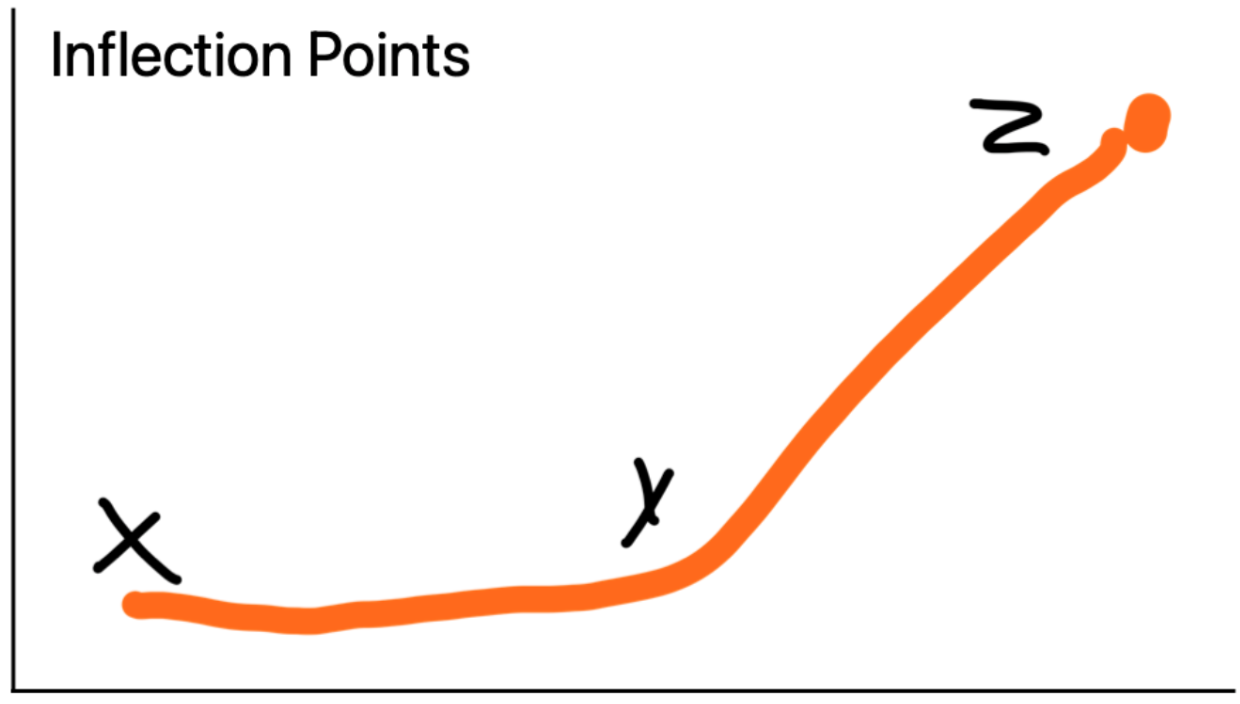KEY TAKEAWAY:
--Whether your actions caused the hockey stick growth or whether you just got lucky, you need a new strategy that takes into account the new reality while giving yourself the space to think about your identity and what activities need to be discontinued.
----------
I’m fascinated by inflection points within organizations. These are periods of rapid growth or change such as technology startups go through if they manage to find product-market fit. When these companies pitch venture capitalists, they often have a chart showing “hockey stick growth,” which is another way of demonstrating an inflection point.

Inflection points are caused because of actions taken by an organization or because of fundamental changes in the world around them. When pandemic restrictions were imposed around the world, Peloton experienced an inflection point in demand for their product. Nothing had radically changed about their product, but a good chunk of the world couldn’t leave their houses. Peloton eventually fell back to earth, unable to sustain their good fortune once restrictions were lifted.
In this article, I want to touch on the three ideas related to dealing with inflection points and how your organization can be better prepared for a possible future or an existing present.
You Need a New Strategy
I’m talking to an executive of an organization that is doing really well. They have surpassed all of their growth targets within a couple of years of a five-year strategy. Putting aside the anachronistic nature of five-year strategic plans, it was obvious to me that this organization needed a new strategy altogether.
If we use the chart above as reference, we can see that this organization formulated their strategy at point X. Their strategy had several assumptions about the future that were no longer true. Continuing on the same plan wouldn’t take into account the plethora of opportunities now available because of the inflection point. It doesn’t matter that there’s three years left, because the plan is no longer rooted to reality.
I worked with another organization that was also experiencing an inflection point. The difference was this organization knew they needed a new strategy. In a short time, they realized they needed to be stricter about their criteria for expansion and not risk overextending themselves.
When management teams face inflection points, there’s a tendency to keep doing the same things. After all, isn’t that what created the inflection in the first place?
Yes and no. It is possible that past actions directly contributed to the inflection. Think about Apple and the popularity of products like AirPods, which depended on the success of the iPhone. It is also possible that conditions in the world changed without your input. Think about airlines and the massive rebound of leisure travel that occurred after the pandemic.
Regardless of the cause of the inflection point, an organization needs to reevaluate their strategy and ensure that it still makes sense for where they want to go.
What Does Your Organization Need to Be?
There are many strategic frameworks out there, but I contend that inflection points require organizations to answer one important question.
What does your organization need to reach point Z in the chart above?
Think about what kind of organization is needed to successfully operate in the future and then determine what decisions are congruent with that identity.
When Uber started, it faced all kinds of legal challenges. They approached the battles with a war mindset, willing to fight in every city and country around the world. There’s no denying that this identity helped them break into a monopolistic industry that had rejected technology. At some point, Uber went from underdog to established player, but it didn’t change its identity. It took the public exit of the founder and CEO for Uber to shed its hostile culture.
See also: Cyber Insurance at Inflection Point
What needs to be discontinued?
Continual growth, especially in an inflection point, requires equally aggressive discontinuation of certain activities, products and markets.
Sears successfully moved through multiple inflections by decreasing the focus on activities that had made them highly successful in the past. While Sears made their name with their catalog and shipping products by railroad, they eventually replaced all of that with retail stores. They noticed the demographic and cultural changes—migration to urban centers, the rise of the car and the increase in consumer spending after WWII—and successfully discontinued the model that made them successful. But they failed to discontinue their stores and move to ecommerce (like Amazon).
As you rethink your strategy, you should have a clear plan for how you will get out of specific products or markets. They may be highly profitable or politically important but the consideration has to be whether these activities will fit in your new future. Be wary of activities that consume a disproportionate amount of time and resources.
Conclusion
Inflection points are a good problem to have, but they can quickly turn into just problems. Regardless of what caused them, organizations need a new strategy that takes into account the new reality while giving them the space to think about their identity and what activities need to be discontinued. You can ride inflections to new heights, but doing so requires careful thinking on how to survive at higher altitudes.








